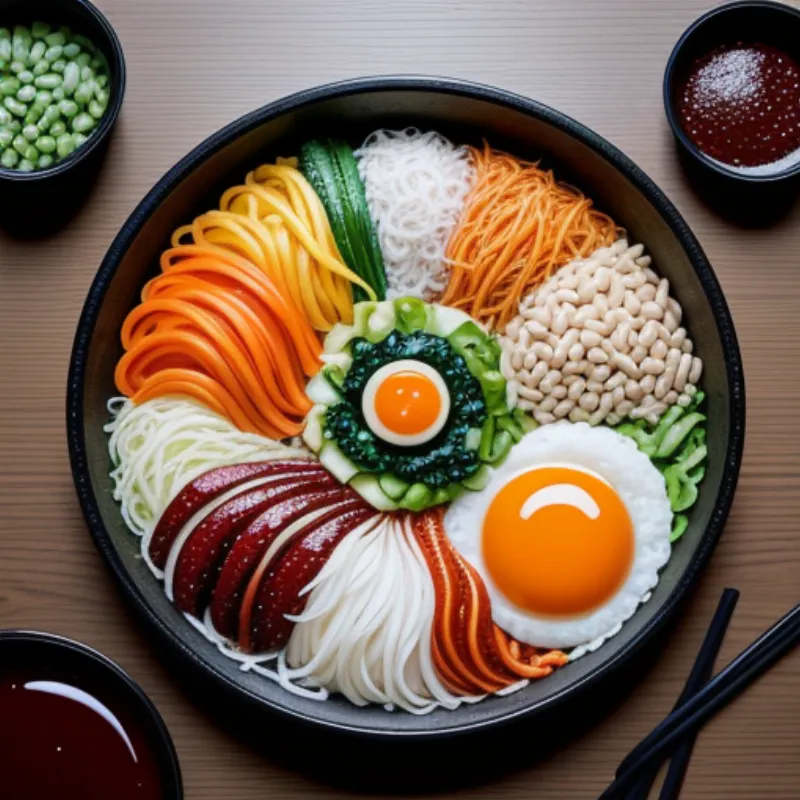Vegetable Bibimbap, with its vibrant colors and fresh flavors, is a true celebration of Korean cuisine. “Bibimbap” literally translates to “mixed rice,” and this dish is all about creating a symphony of textures and tastes in every bite. Imagine tender-crisp vegetables, perfectly cooked rice, and a spicy, savory sauce, all coming together in a beautiful harmony.
Whether you’re a seasoned vegetarian or simply looking to incorporate more plant-based meals into your diet, this recipe is for you. It’s surprisingly easy to make and endlessly customizable. So, put on your apron, and let’s embark on a culinary adventure to the heart of Korea!
Gather Your Ingredients
For the Vegetables:
- 1 cup short-grain white rice
- 1 medium zucchini, julienned
- 1 medium carrot, julienned
- 1 cup spinach, washed
- 1/2 cup mung bean sprouts, rinsed
- 1/2 cup kimchi, chopped (optional)
- 2 tablespoons sesame oil
- 1 tablespoon soy sauce
- 1 teaspoon toasted sesame seeds
- Salt and pepper to taste
For the Sauce:
- 2 tablespoons gochujang (Korean red chili paste)
- 1 tablespoon soy sauce
- 1 tablespoon rice vinegar
- 1 teaspoon sugar
- 1 teaspoon sesame oil
- 1/2 teaspoon minced garlic
- Pinch of gochugaru (Korean chili flakes) – optional
For the Topping:
- 1 fried egg (optional)
- Chopped scallions for garnish
 Vegetable Bibimbap Ingredients
Vegetable Bibimbap Ingredients
Tools of the Trade
- Large skillet or wok
- Medium pot
- Small bowl for sauce
Let’s Get Cooking!
Preparing the Rice:
- Rinse the rice under cold water until the water runs clear. This removes excess starch.
- Cook the rice according to package directions.
Cooking the Vegetables:
- While the rice is cooking, prepare your vegetables.
- Heat 1 tablespoon of sesame oil in a skillet over medium heat.
- Add the zucchini and carrot, and stir-fry for 3-4 minutes, until slightly softened. Season with a pinch of salt and pepper.
- Add the spinach and mung bean sprouts to the skillet and cook for another 2-3 minutes, until wilted.
- Remove the vegetables from the heat and set aside.
Making the Sauce:
- In a small bowl, combine all the sauce ingredients (gochujang, soy sauce, rice vinegar, sugar, sesame oil, minced garlic, and gochugaru, if using).
- Whisk until smooth and well combined.
Assembling Your Bibimbap:
- Divide the cooked rice into bowls.
- Arrange the cooked vegetables over the rice.
- Add a dollop of kimchi, if desired.
- Top with a fried egg (optional).
 Assembling Vegetable Bibimbap
Assembling Vegetable Bibimbap
Tips and Tricks for Bibimbap Perfection
- Rice is Key: For authentic Bibimbap, use short-grain white rice. It has a slightly sticky texture that holds the bowl together beautifully.
- Vegetable Variety: Feel free to get creative with your vegetables! Bean sprouts, mushrooms, bell peppers, and even thinly sliced marinated tofu would make delicious additions.
- Spice Level: Adjust the spiciness of the sauce to your preference by adding more or less gochujang or gochugaru.
- Fried Egg Perfection: For a runny yolk that adds richness to your Bibimbap, fry your egg over low heat and avoid overcooking.
Serving and Enjoying Your Masterpiece
Serve your Vegetable Bibimbap immediately with the sauce on the side. Just before eating, drizzle the sauce over the top and mix all the ingredients together. This ensures that all the flavors meld together beautifully.
Garnish with chopped scallions and a sprinkle of toasted sesame seeds for an extra touch of flavor and visual appeal.
Vegetable Bibimbap is a dish that’s as fun to eat as it is to make. It’s a delicious and healthy meal that’s perfect for any occasion. So gather your ingredients, embrace your inner chef, and enjoy the vibrant flavors of Korea!
Want to explore more Korean flavors? Check out our recipe for Jeyuk Bokkeum Sauce, a spicy and savory sauce that’s perfect for stir-fries and marinades.
